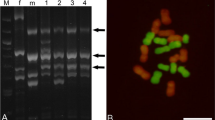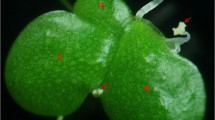Abstract
Forsythia suspensa and F. ‘Courtaneur’ were used as female parents to cross with Abeliophyllum distichum in 2011 and an intergeneric hybrid of F. suspensa × A. distichum was obtained, though with very low seed set. The morphological characteristics, flower fragrance and volatile organic compounds of flowers were analysed. The intergeneric hybrid had intermediate morphological characteristics of both parents and flower fragrance and was confirmed as a true intergeneric hybrid by amplified fragment length polymorphism (AFLP) markers. Compared with its mother parent (F. suspensa), flowers of the intergeneric hybrid are pale yellow with delicate fragrance. Volatile organic compounds of flowers were retrieved by purge-and-trap techniques, and determined by gas chromatography and mass spectrometry (GC–MS). The main volatile organic components of F. suspensa were isoprenoids, while the main volatile organic components of A. distichum and the hybrid of F. suspensa × A. distichum were aliphatics. To determine the time and the site of intergeneric hybridizing barriers occured, the pollen tubes’ behavior after pollination was observed under fluorescence microscopy. It was found that significant pre-fertilization incompatibility existed in intergeneric crossing combinations [F. ‘Courtaneur’ (Pin) × A. distichum (Thrum) and F. suspensa (Pin) × A. distichum (Thrum)], and only a few pollen tubes of A. distichum penetrated into the ovaries of Forsythia. In our research, an intergeneric hybrid between Forsythia and Abeliophyllum was obtained for the first time, which will provide a solid foundation for expanding the flower color range of Forsythia and breeding fragrant-flowered cultivars.


Similar content being viewed by others
References
Ajmone MP, Castiglioni P, Fusari F, Kuiper M, Motto M (1998) Genetic diversity and its relationship to hybrid performance in maize as revealed by RFLP and AFLP markers. Theor Appl Genet 96(2):219–227
Bi XY, Li H, Lou Q, Zheng Y (2012) Studies on inter-generic compatibility of Iris dichotoma and Belamcanda chinensis and their hybrids identification. Acta Hort Sin 39(5):931–938
Chen J, Staub J, Qian C, Jiang J, Luo X, Zhuang F (2003) Reproduction and cytogenetic characterization of interspecific hybrids derived from Cucumis hystrix Chakr × Cucumis sativus L. Theor Appl Genet 106(4):688–695
Chen ML, You YL, Zhang XP (2010) Advances in the research of heterostyly. Acta Prataculturae Sin 19(1):226–239
David WC, John WD, Philippe D (2015) An automated, high through-put method for accurate and precise measurements of dissolved nitrous-oxide and methane concentrations in natural waters. Limnol Oceanogr Methods 13(7):345–355
Diego M, Marina A, Eugenia EC, Rea CP (2012) Interspecific and intergeneric hybridization in south American Rhamnaceae-Colletieae. Plant Syst Evol 298(8):1425–1435
Forero DP, Orrego CE, Peterson DG, Osorio C (2015) Chemical and sensory comparison of fresh and dried lulo (Solanum quitoense Lam.) fruit aroma. Food Chem 169:85–91
Grzebelus D, Senalik D, Jagosz B, Simon PW, Michalik B (2001) The use of AFLP markers for the identification of carrot breeding lines and F1 hybrids. Plant Breed 120(6):526–528
Haldane JBS (1922) Sex ratio and unisexual sterility in hybrid animals. J Genet 12(2):101–109
Hong SP, Mae-Ja H (2002) The floral dimorphism in the rare endemic plant, Abeliophyllum distichum Nakai (Oleaceae). Flora 197(7):317–325
Hong YP, Lin BS, Hong YC, Lin SQ (2011) Chemical constituent and antimicrobial activity of essential oil from fragrant loquat and common loquat. Appl Mech Mater 138–139:974–980
Jeite TK, Lars TL, Gunnar B (1993) Floral scents-A checklist of volatile compounds isolated by head-space techniques. Phytochmistry 33(2):253–280
Jette TK, Roger E, Jonathan GBS (2006) Diversity and distribution of floral scent. Bot Rev 72(1):1–120
Kang U, Chin-Sung C, Yong SK (2000) Genetic structure and conservation considerations of rare endemic Abeliophyllum distichum Nakai (Oleaceae) in Korea. J Plant Res 113(2):127–138
Katarzyna K, Henrik L, Brian C, Renate M (2015) Quantitative and qualitative characterization of novel features of Kalanchoe interspecific hybrids. Euphytica 205(3):927–940
Katarzyna K, Henrik L, Renate M (2016) Towards development of new ornamental plants: status and progress in wide hybridization. Planta. doi:10.1007/s00425-016-2493-7
Kho YO, Baer J (1968) Observing pollen tubes by means of fluorescence. Euphytica 17(2):298–302
Kim KJ (1998) Phylogenetic position of the olive family (Oleaceae) and their intergeneric relationships. The 30th meeting of the plant taxonomy society of Korea. (abstract)
Knudsen JT, Tollsten L, Bergström LG (1993) Floral scents- a checklist of volatile compounds isolated by head-space techniques. Phytochemistry 33(2):253–280
Knudsen JT, Eriksson R, Gershenzon J, Bertil S (2006) Diversity and distribution of floral scent. Bot Rev 72(1):1–120
Kong Y, Sun M, Pan HT, Zhang QX (2012) Composition and emission rhythm of floral scent volatiles from eight lily cut flowers. J Am Soc Hortic Sci 137(6):376–382
Li SS, Chen LG, Xu YJ, Wang LJ, Wang LS (2012) Identification of floral fragrances in tree peony cultivars by gas chromatography-mass spectrometry. Sci Hortic 142(4):158–165
Liu HF, Chen XX, Duan CG, Yang HH, Feng BM (2004) Embryo rescue and identification of hybrids between sweet cherry and Chinese cherry. Acta Hortic Sin 31(3):303–308
Lutter R, Tullus A, Tullus T, Tullus H (2016) Spring and autumn phenology of hybrid aspen (Populus tremula L. × P. tremuloides Michx.) genotypes of different geographic origin in hemiboreal Estonia. NZ J For Sci 46:20. doi:10.1186/s40490-016-0078-7
Maria EC, Marilena CF, Vania S, Massimo M (2015) Obtainment of inter-subspecific hybrids in olive (Olea europaea L.). Euphytica 201(2):307–319
McGrath JM, Quiros CF (1991) Intersubspecies hybrids and their progeny in Brassica campestris. J Am Soc Hortic Sci 116(2):349–355
Muhlemann JK, Klempien A, Duareva N (2014) Floral volatiles: from biosynthesis to function. Plant Cell Environ 37(8):1936–1949
Ramarathnam N, Rubin LJ, Diosady LL (1993) Studies on meat flavor. 3. A novel method for trapping volatile components from uncured and cured pork. J Agr Food Chem 41(6):933–938
Reed SM, Keri D, Jones KD, Rinehart TA (2008) Production and characterization of intergeneric hybrids between Dichroa febrifuga and Hydrangea macrophylla. J Am Soc Hort Sci 133(1):89–91
Rehder A (1891) Über Dimorphismus bei Forsythia. Gartenflora 40:395–400
Rieseberg LH, Carney SE (1998) Plant hybridization. New Phytol 140(4):599–624
Rosati C, Cadic A, Duron M, Simoneau P (2007) Forsythia. Biotechnol agriculture and forestry. In: Pua EC, Davey MR (eds) Transgenic Crops VI, vol 61., pp 299–318
Ryu TY, Yeam DY, Kim YJ, Kim SJ (1976) Studies on heterostyly incompatibility of Abeliophyllum distichum. Seoul Nat. Univ. Coll Agri Bull 1:113–120
Saghai-Maroof MA, Soliman KM, Jorgensen RA, Allard RW (1984) Ribosomal DNA spacer length polymorphism in barley: mendelian inheritance, chromosomal location and population dynamics. Proc Natl Acad 81(24):8014–8018
Sampson DR (1971) Mating group ratios in distylic Forsythia (Oleaceae). Can J Genet Cytol 13(2):368–371
Tang XL, Liu YM, Pan HT, Ma YL, Li XY, Zhang QX (2014) Intergeneric cross-compatibility between Primula forbesii (Section Monocarpiae) and Primula saxatilis (Section Cortusoides). Acta Bot Boreal 24(2):0270–0275
Utchang K, Chin-Sung C, Yong SK (2000) Genetic structure and conservation considerations of rare endemic Abellophyllum distichum Nakai (Oleaceae) in Korea. J Plant Res 113(2):127–138
Van Tuyl JM, De Jeu MJ (1997) Methods for overcoming interspecific crossing barriers. In: Shivanna KR, Sawhney VK (eds) Pollen biotechnology for crop production and improvement. Cambridge Univ Press, London, pp 273–292
Xie ZP, Wang L, Wang LR, Wang ZQ, Lu ZH, Tian DC, Yang SH, Hurst LD. (2016) Mutation rate analysis via parent-progeny sequencing of the perennial peach. I. A low rate in woody perennials and a higher mutagenicity in hybrids. Proc R Soc B 283: 20161016. http://dx.doi.org/10.1098/rspb.2016.1016
Ye YJ, Liu Y, Cai M, He D, Shen JS, Ju YQ, Bian XM, Pan HT, Zhang QX (2015) Screening of molecular markers linked to dwarf trait in crape myrtle by bulked segregant analysis. Genet Mol Res 14(2):4369–4380
Acknowledgements
This study was funded by by the Fundamental Research Fund for the Central University (2015ZCQ-YL-03).
Author information
Authors and Affiliations
Corresponding author
Ethics declarations
Conflict of interest
The authors declare that they have no conflict of interest.
Rights and permissions
About this article
Cite this article
Shen, J., Xu, T., Shi, C. et al. Obtainment of an intergeneric hybrid between Forsythia and Abeliophyllum . Euphytica 213, 95 (2017). https://doi.org/10.1007/s10681-017-1880-x
Received:
Accepted:
Published:
DOI: https://doi.org/10.1007/s10681-017-1880-x




